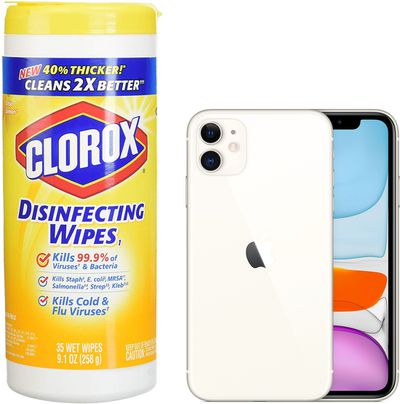Amid Coronavirus Outbreak, Apple Confirms That It's Okay to Clean Your iPhone With Disinfectant
Apple today updated its support document on cleaning Apple products with new information that confirms it's okay to to use a 70 percent isopropyl alcohol wipe or Clorox Disinfecting Wipes for the purpose of cleaning germs from your devices.

Prior to now, Apple's cleaning guidelines have recommended against all cleaners, warning that the chemicals have the potential to damage the oleophobic coating on iPhone and iPad displays. Apple still warns against aerosol sprays, ammonia, window cleaners, hydrogen peroxide, bleach, compressed air, and abrasives:
Using a 70 percent isopropyl alcohol wipe or Clorox Disinfecting Wipes, you may gently wipe the hard, nonporous surfaces of your Apple product, such as the display, keyboard, or other exterior surfaces. Don't use bleach. Avoid getting moisture in any opening, and don't submerge your Apple product in any cleaning agents. Don't use on fabric or leather surfaces.
Apple also says to avoid spraying cleaners directly onto your devices and to avoid getting moisture into the openings.
Apple's updated guidelines come as the coronavirus continues to spread around the world. Given that most people use their iPhones and other devices constantly, it's important to be able to disinfect them to cut down on virus spread through surfaces.
It's not entirely clear how long the virus lasts on surfaces, but various studies have found that it can survive on glass or plastic for as little as two hours or as long as nine days.
The Wall Street Journal's Joanna Stern tested Apple's new guidelines over the course of the last week. Using a new iPhone 8, she wiped the display 1,095 times with Clorox Disinfecting Wipes, the estimated equivalent of the number of times an iPhone might be cleaned over the course of three years.
After all the wiping, the oleophobic coating on the iPhone's display was in good condition with no perceived damage.
Popular Stories
Despite being more than two years old, Apple's AirPods Pro 2 still dominate the premium wireless‑earbud space, thanks to a potent mix of top‑tier audio, class‑leading noise cancellation, and Apple's habit of delivering major new features through software updates. With AirPods Pro 3 widely expected to arrive in 2025, prospective buyers now face a familiar dilemma: snap up the proven...
Apple's iPhone development roadmap runs several years into the future and the company is continually working with suppliers on several successive iPhone models simultaneously, which is why we often get rumored features months ahead of launch. The iPhone 17 series is no different, and we already have a good idea of what to expect from Apple's 2025 smartphone lineup.
If you skipped the iPhone...
Apple is preparing a "bold" new iPhone Pro model for the iPhone's 20th anniversary in 2027, according to Bloomberg's Mark Gurman. As part of what's being described as a "major shake-up," Apple is said to be developing a design that makes more extensive use of glass – and this could point directly to the display itself.
Here's the case for Apple releasing a truly all-screen iPhone with no...
While the iPhone 17 Pro and iPhone 17 Pro Max are not expected to launch until September, there are already plenty of rumors about the devices.
Subscribe to the MacRumors YouTube channel for more videos.
Below, we recap key changes rumored for the iPhone 17 Pro models as of April 2025:
Aluminum frame: iPhone 17 Pro models are rumored to have an aluminum frame, whereas the iPhone 15 Pro and ...
If you have been experiencing issues with wireless CarPlay in your vehicle lately, it was likely due to a software bug that has now been fixed.
Apple released iOS 18.4.1 today, and the update's release notes say it "addresses a rare issue that prevents wireless CarPlay connection in certain vehicles."
If wireless CarPlay was acting up for you, updating your iPhone to iOS 18.4.1 should...
Apple seeded the third beta of iOS 18.5 to developers today, and so far the software update includes only a few minor changes.
The changes are in the Mail and Settings apps.
In the Mail app, you can now easily turn off contact photos directly within the app, by tapping on the circle with three dots in the top-right corner.
In the Settings app, AppleCare+ coverage information is more...
This week saw rumor updates on the iPhone 17 Pro and next-generation Vision Pro, while a minor iOS 18.4.1 update delivered not just security fixes but also a fix for some CarPlay issues.
We also looked ahead at what else is in Apple's pipeline for the rest of 2025 and even the 20th-anniversary iPhone coming in 2027, so read on below for all the details on these stories and more!
iPhone 17 ...






















